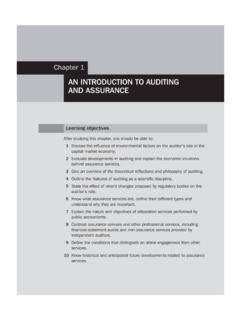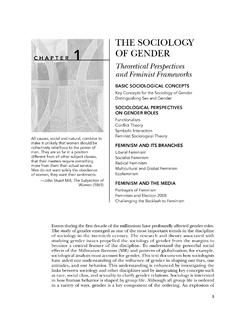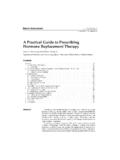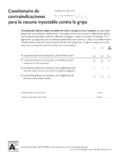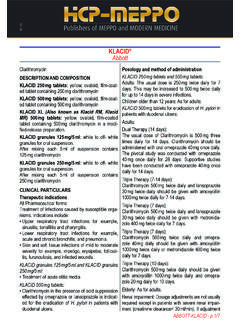Transcription of CHAPTER Intravenous Fluid Selection - Pearson UK
1 Intravenous FluidSelectionCHAPTER3 GRIDLINE SET IN 1ST-PP TO INDICATE SAFE AREA; TO BE REMOVED AFTER 1ST-PPLEARNING OBJECTIVESBy the end of this CHAPTER , you should be able to: Describe and differentiate colloid and crystalloid IV fluids Understand osmosis as it pertains to water movement with IVtherapy Define tonicity and the actions of isotonic, hypotonic, andhypertonic crystalloids in the body Identify the three most common IV solutions used in theprehospital setting, and classify them as isotonic, hypotonic,or hypertonic Describe how an IV Fluid is packaged and important informa-tion located on the label of the IV fluidKEY TERMS5% Dextrose in water A carbohydrate solution that uses glucose(sugar) as the solute dissolved in sterile water.
2 Five percent dextrose inwater is packed as an isotonic solution but becomes hypotonic oncein the body because the glucose (solute) dissolved in sterile water ismetabolized rapidly by the body s solutions IV fluids containing large proteins and moleculesthat tend to stay within the vascular space (blood vessels).Crystalloid solutions IV fluids containing varying concentrations See 5% dextrose in space Space outside the cells consisting of the intravas-cular and interstitial 3/9/05 18:24 Page 20 seema Seema-3:Desktop Folder:PQ731:EQACHAPTER 3 Intravenous Fluid Selection21 GRIDLINE SET IN 1ST-PP TO INDICATE SAFE AREA; TO BE REMOVED AFTER 1ST-PPHypertonic crystalloid A crystalloid solution that has a higher concen-tration of electrolytes than the body crystalloid A crystalloid solution that has a lower concen-tration of electrolytes than the body space Space within the volume Volume of blood contained within the fluids Chemically prepared solutions that are adminis-tered to a patient through the IV crystalloid A crystalloid solution that has the same concen-tration of electrolytes as the body Ringer s An isotonic crystalloid solution containing thesolutes sodium chloride, potassium chloride, calcium chloride, andsodium lactate, dissolved in sterile water (solvent).
3 LR See Lactated Ringer saline solution An isotonic crystalloid solution that containssodium chloride (salt) as the solute, dissolved in sterile water (solvent).The specific concentration for normal saline solution is See Normal saline See Normal saline The movement of water across a semipermeable membranefrom an area of lower solute concentration to an area of higher soluteconcentration. This movement of water allows the equalization of thesolute-to-solution ratio across the solutions Chemically prepared solutions that cancarry oxygen to the Fluid surrounding the cells of the s lactate See Lactated Ringer Particles that are dissolved in the sterile water (solvent) of an The liquid portion of an IV solution that the solute(s) dissolvesinto.
4 The most common solvent is sterile body water Water contained within the cells, around the cells,and in the bloodstream. Water comprises about 60% of the body StudyYou are staffing a first aid center for the city s 5-kilometer run forcharity. With the temperature at 96oF and the humidity at 92%, thefirst aid center is overwhelmed with patients suffering from dehy-dration. Because IV therapy is within your scope of practice, the leadphysician instructs you to start an IV and administer IV Fluid to a32-year-old female who is seriously dehydrated and extremely 3/9/05 18:24 Page 21 seema Seema-3:Desktop Folder:PQ731:EQAA fter accessing the patient s airway, breathing, and circulationand applying high-flow oxygen, you proceed to the medical supplyarea to get the IV Fluid .
5 There you find a variety of fluids, includingisotonic crystalloids, hypertonic crystalloids, hypotonic crystalloids,and a refrigerator of colloid solutions. What Fluid will you select forthis patient?In this CHAPTER , different types of IV fluids are presented, alongwith their specific actions within the body. The manner in which IVfluids are packaged is also discussed. At the end of the CHAPTER ,we return to this case and apply our How might the clinical condition of dehydration affect your abil-ity to locate and access a vein for IV therapy?2. Would 5% dextrose in water (D5W) be an acceptable IV Fluid touse for the rehydration of this patient?3. If NSS was not available, what other isotonic crystalloidwould be acceptable to use in its place?
6 INTRODUCTIONI ntravenous fluidsare chemically prepared solutions that are administeredto the patient. They are tailored to the body s needs and used to replace lostfluid and/or aid in the delivery of IV medications. For patients that do notrequire immediate Fluid or drug therapy, the continuous delivery of a smallamount of IV Fluid can be used to keep a vein patent (open) for future fluids come in different forms and have different impacts on the , it is important to have an understanding of the different types ofIV fluids, along with their indications for Intravenous Fluids Are CreatedThere are several types of IV fluids that have different effects on the IV fluids are designed to stay in the intravascular space (intra,within;vascular,blood vessels) to increase the intravascular volume,or volume ofcirculating blood.
7 Other IV fluids are specifically designed so the Fluid leavesthe intravascular space and enters the interstitial and intracellular spaces. Stillothers are created to distribute evenly between the intravascular, interstitial,and cellular spaces. The properties that an IV solution has within the bodydepends on how it is created and the specific materials it contains. It also de-termines the best type of IV solution to use in relation to the patient s majority of an IV solution is sterile water. Chemically, water isreferred to as a solvent. A solvent is a substance that dissolves othermaterials called solutes. Within IV solutions, the solutes can be moleculescalled electrolytes (charged particles such as sodium, potassium, andchloride) and/or other larger compounds such as proteins or 3 Intravenous Fluid SelectionGRIDLINE SET IN 1ST-PP TO INDICATE SAFE AREA; TO BE REMOVED AFTER 1ST-PPOn TargetNot all IV fluids are thesame.
8 Different IV fluidshave different actionswithin the 3/9/05 18:24 Page 22 seema Seema-3:Desktop Folder:PQ731:EQACHAPTER 3 Intravenous Fluid Selection23 GRIDLINE SET IN 1ST-PP TO INDICATE SAFE AREA; TO BE REMOVED AFTER 1ST-PPOn TargetAlthough colloids are aneffective IV solution forincreasing a patient sblood volume, theirexpense and specificstorage requirementslimit their use in theprehospital TargetIV fluids are comprisedof solutes dissolved in , the solvent(water) and solutes(electrolytes, proteins, or othermolecules dissolved in the water) create the IV solution. Consider a cup ofcoffee to which sugar is added for sweetness. The coffee is the solvent,which dissolves the solute FluidsIV fluids come in four different forms: Colloids Crystalloids Blood and blood products Oxygen-carrying solutionsUnderstanding these IV fluids is important because each has a differentimpact on the body and particular indications for use: Colloid Solutions.
9 Colloid solutionsare IV fluids that contain solutes inthe form of large proteins or other similarly sized molecules. The pro-teins and molecules are so large that they cannot pass through the wallsof the capillaries and onto the cells. Accordingly, colloids remain inthe blood vessels for long periods of time and can significantly increasethe intravascular volume (volume of blood). The proteins also have theability to attract water from the cells into the blood vessels. However,although the movement of water from the cells into the bloodstreammay be beneficial in the short term, continual movement in this direc-tion can cause the cells to lose too much water and become are useful in maintaining blood volume, but their use in thefield is limited.
10 Colloids are expensive, have specific storage require-ments, and have a short shelf life. This makes their use more suitable inthe hospital setting. However, familiarity is important because in amass casualty incident the EMT may be required to assist with the ad-ministration of colloids either in a field hospital or during the transportof critically injured patients. Commonly used colloid solutions includeplasma protein fraction, salt poor albumin, dextran, and hetastarch. Tolearn more about colloidal solutions, the EMT should consult a criticalcare or paramedic textbook. Crystalloid Solutions. Crystalloid solutionsare the primary Fluid usedfor prehospital IV therapy. Crystalloids contain electrolytes ( ,sodium, potassium, calcium, chloride) but lack the large proteins andmolecules found in colloids.





